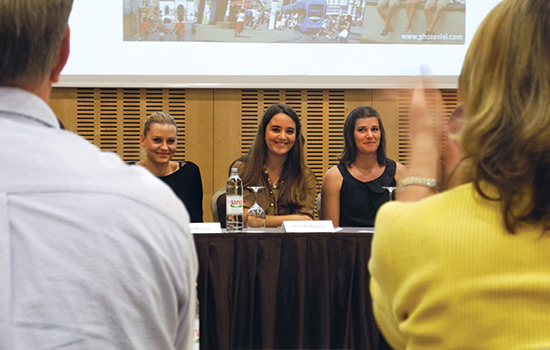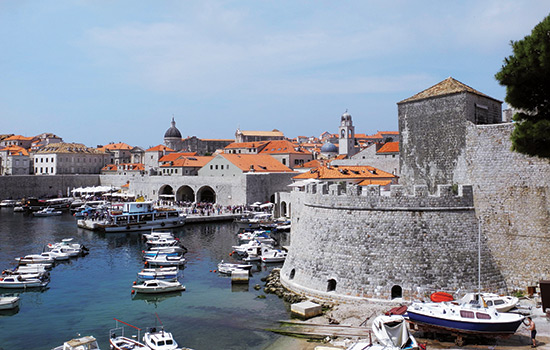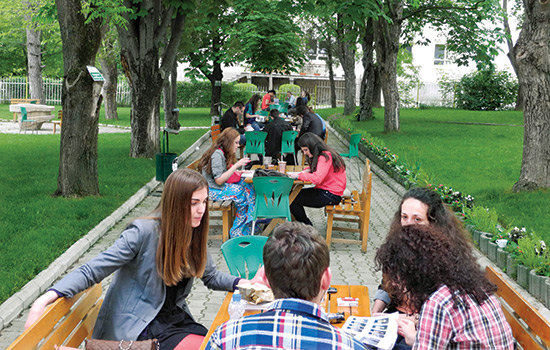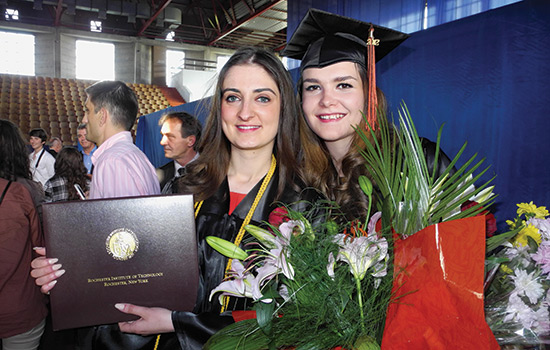International intelligence
Bob Finnerty
Dorina Grezda, left, and Donjeta Sahatciu celebrate earning their RIT diplomas at the American University in Kosovo.
Thousands of kilometers away from their homelands, Deni Paskojevic and Donjeta Sahatciu were in awe when they participated in RIT’s 127th commencement ceremonies in May.
It was the first trip to the RIT Henrietta campus for both honor students. Perhaps this was an improbable journey for the two young women, who as children survived the Yugoslav Wars of the 1990s.
Days after the ceremony in suburban Rochester, the jet-lagged Paskojevic and Sahatciu returned to southeast Europe and celebrated graduation again: Paskojevic with her classmates at RIT’s American College of Management and Technology in Dubrovnik, Croatia; Sahatciu with her friends at American University in Kosovo, operated by RIT in Pristina, Kosovo.
“I became aware on the trip to RIT that we are a part of this much larger group of students from all around the world,” says Paskojevic. “My experience at RIT and ACMT has helped me see the bigger picture.”
“I had an exceptional experience at RIT and American University in Kosovo,” says Sahatciu. “We are part of a global community. Phenomenal.”
Paskojevic is now considering the master’s program in service leadership and innovation at RIT Dubai. Sahatciu will likely return to RIT’s Henrietta campus and pursue an MBA.
With no confining boundaries, Paskojevic and Sahatciu illustrate the experience university leaders are seeking for every RIT graduate. RIT President Bill Destler is striving for all students to gain “global intelligence” so that they will be able to understand and function in an increasingly multicultural and international environment. That was the message heard by a dozen members of the Board of Trustees, who for the first time traveled overseas as a group to see RIT’s ACMT campuses in Croatia this spring.
The RIT leadership views its branch campuses in Croatia, Kosovo and Dubai in many ways as a launching pad for future international endeavors. In Dubrovnik, the trustees discussed what direction RIT should take next in terms of strategic global expansion. Along with branch campuses, RIT has relationships with more than 60 nations.
Should RIT be doing more in India, China, Latin America? What’s the best economic model? How can the university increase the number of American students studying abroad? How can RIT attract more international students to Rochester? These are all complex questions for university leadership to consider.
“While Kosovo, Croatia and Dubai may not be the first places you think of for overseas locations, RIT was invited to help fulfill a real need in developing these countries,” says Destler. “These are locations where RIT can have an immediate impact. And we have … RIT is already one of the most engaged universities internationally you will find anywhere in the world.”
Pearl in the Adriatic
The walls outside the old city of Dubrovnik are impressive with forts and towers, forever protecting its citizens. The ancient city has held off potential invaders since the 13th century. This includes as recently as 1991 when the city was shelled during the turmoil of the Yugoslav Wars. The city persevered yet again and the war ended in 1995.
RIT entered the scene in 1997 with the formation of ACMT. The college offers academic programs in information technology; tourism, hospitality and service management; and international business. The city is now a booming tourism destination along the Adriatic Sea with thousands entering Dubrovnik each day on cruise ships. “We are very proud about making a significant contribution to the tourism industry of Croatia, particularly in the post-war recovery period,” says Don Hudspeth, president and dean of ACMT.
ACMT opened up a second campus last year in the Croatian capital of Zagreb focused on international business and information technology. ACMT is planning for academic expansion in both Croatian locations in undergraduate and graduate programs in advertising and public relations, human resources development and service leadership innovation. Croatia joins the European Union in 2013 and Hudspeth sees this as another opportunity to attract students from throughout Europe.
“The American education model certainly has a place here and we have proven that a private education adds to the academic offering in Croatia,” says Hudspeth. “Another key element is study abroad with students coming from RIT and other sites, such as RIT Dubai, to see what we have to offer in Croatia. This is all part of the RIT network.”
Paskojevic, still excited from her trip to Rochester, tells the trustees how her practical experiences at ACMT helped her “see the picture of a career.” She commended the ACMT faculty for being accessible and project driven.
“ACMT is a privilege,” adds Hanan Besovic, a tourism, hospitality and service management major. “It’s an experience, not just an education.”
But during the visit, the trustees also want to know what could be improved at ACMT. “We are looking for more of an academic challenge,” Dora Oresic tells the board. “We have met students from RIT and we notice we are not quite on par with RIT students academically. We are looking for more real-life problems to solve.”
That said, Oresic has already done multiple co-ops in Dubrovnik and is finding she has an edge in the workforce. She feels confident she can work at any hotel in the world. “The industry leaders are telling us we are more employable because of our co-op and practical experience.”
Youth power
About 300 kilometers to the southeast of Croatia is Kosovo, which also was a part of the former Yugoslavia. Kosovo, which declared independence as a sovereign nation in 2008, is Europe’s youngest country. Median age: 26.
Youth brings a spirit of optimism in Kosovo. American University in Kosovo President Christopher Hall says the new graduates will make a huge difference as Kosovo continues to rebuild as an independent nation. There is much work to be done with the unemployment rate above 40 percent. “We have done our best to prepare them well for their careers, and I sincerely hope that they will join their peers in contributing in building a new country,” says Hall. “It’s an exciting time to be in Kosovo.”
Sahatciu, he believes, is one of those future leaders. She is American University in Kosovo’s valedictorian and she calls her graduation the “best day of my life.” At the ceremony downtown in the capital city of Pristina, the president of Kosovo, Atifete Jahjaga, speaks to Sahatciu and her American University in Kosovo classmates: “Be part of the debate in which direction our nation takes. And be the masters of your own future.”
After the ceremony, RIT President Destler tells a group of faculty that he is impressed. “It is amazing to build a campus from the ground up in less than 10 years. What you are doing is noble work.”
Like Hudspeth at ACMT, Hall has a message for American students to study abroad at American University in Kosovo: “Kosovo is a small country where you can see how a country works. Students back in Rochester can come here and make a difference to society. Come and be a part of it.”
Global mobility
Indeed, RIT leaders want to increase the number of American students studying abroad. The goal is to move from 275 study abroad students today to 350 by 2015. The change from an academic quarter system to semesters in 2013 is expected to play a role in reaching the goal.
To survive in the global marketplace, RIT students will need an international flavor as part of their experience, says Trustee Nancy Fein, vice president of supply chain strategy for Toyota Motor Sales, USA.
“RIT’s true mission is to prepare people for jobs. And jobs today are global,” says Fein. “All of our companies are global and the world is an open page for everyone. If you look at any industry, they are stretching their reach to China, they are stretching their reach to the Middle East. We all need to be a part of that if we are going to prepare our students for the future.”
The melting pot must also occur on the RIT campus. In higher education, mobility in the world is changing rapidly. Universities in the United States are still the number one destination for foreign students to enroll. The increase of international students enrolling in America jumped 25 percent in a decade from 582,000 students to 725,000 in 2012. Yet at the same time, American market share for international students has declined from 28 percent to 20 percent. The United Kingdom, France, China and Australia, for example, are all gaining ground on attracting international students.
RIT has experienced steady growth in international students on the main campus, rising from an enrollment of 1,243 in 2007 to 1,862 (50 percent increase) with students representing 109 countries.
Prior to the trustees’ visit to Europe, Jim Myers was named associate provost of international education and global programs, a new position at the university. Myers has been involved in RIT global initiatives since 1999, when he served as the university’s first associate dean at ACMT. He was also instrumental in the establishment of American University in Kosovo.
“Students will need a deep understanding that the world is interconnected economically, socially and even scientifically, where most of our challenges are global,” says Myers. “It’s a really exciting time at RIT on the international front.”
Co-op assignment: Help the youth in Kosovo
Luis Rosario and Duy Nguyen are helping to transform a nation. The RIT students are doing so as part of a UNICEF co-op experience at the Kosovo Innovations Lab in the capital city of Pristina.
UNICEF created the lab in 2010 to create positive social change for Kosovo’s youth. With a median age of 26, Kosovo has the youngest population in Europe. The country is still recovering from Yugoslav wars of the 1990s, and it remains impoverished with an unemployment rate of more than 40 percent.
At the lab, UNICEF encourages innovative projects that use the power of social, mobile and open source technologies. “It fills me with optimism to see such a young country gearing up to make their presence on the world stage,” says Rosario.
Rosario and Nguyen were involved in several UNICEF projects:
- Vaccine management: Working with the Kosovo Ministry of Health, the duo has developed a vaccination form that can be filled out by health workers on smart phones while they are in the field working with families.
- Stop smoking campaign: It is believed that more than half of all children in the country are exposed to smoking environments. The Web campaign raises awareness about smoking risks with online tools.
- Innovation camp: The two helped establish an innovation camp where young people can explore ideas and create an entrepreneurial spirit. The ultimate goal is to create jobs.
“The work that I have done here is something very special and will definitely help the youth in this country,” says Nguyen.
 Students Dora Oresic, left, Deni Paskojevic and Marijana Bello at RIT’s American College of Management and Technology in Dubrovnik, Croatia, react to the applause of RIT Trustee Nancy Fein.
Bob Finnerty
Students Dora Oresic, left, Deni Paskojevic and Marijana Bello at RIT’s American College of Management and Technology in Dubrovnik, Croatia, react to the applause of RIT Trustee Nancy Fein.
Bob Finnerty
 The protected old city of Dubrovnik, Croatia.
Bob Finnerty
The protected old city of Dubrovnik, Croatia.
Bob Finnerty
 Students at the American University in Kosovo gather for a yearbook signing celebration at their campus in Pristina. American University in Kosovo opened with RIT’s help in 2003 and today enrolls 600 students from 20 countries.
Bob Finnerty
Students at the American University in Kosovo gather for a yearbook signing celebration at their campus in Pristina. American University in Kosovo opened with RIT’s help in 2003 and today enrolls 600 students from 20 countries.
Bob Finnerty














